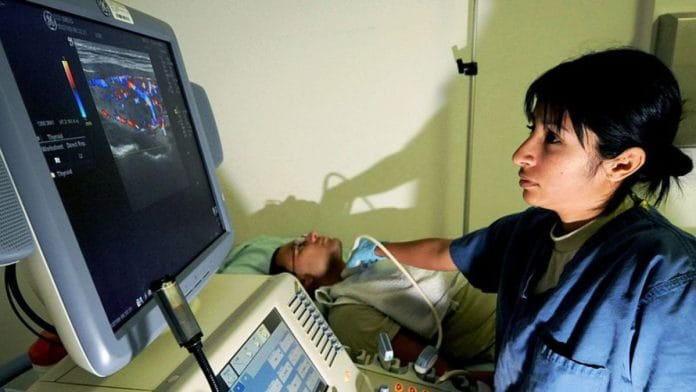New Delhi: Ultrasonography (USG) machines that can track foetus development in the mother’s womb but would not reveal gender are in the works — a development that will likely pave the way for easier access to USGs in cases of complicated pregnancies.
The largest network of private hospitals in the country — Association of Healthcare Providers of India (AHPI) — has reached out to top ultrasound makers to develop the software to allow operators to produce scans without revealing the sex of the foetus, ThePrint has learned.
Ultrasound is a scan that uses high-frequency sound waves to examine internal body structures. These sound waves originate from a vibrating crystal in a handheld scanner, and the reflected sound waves or ‘echoes’ are then translated into a grainy, two-dimensional or, sometimes, three-dimensional image on a monitor. It is used during pregnancy to check the baby’s development and to help pick up any abnormalities such as Down Syndrome, a congenital birth defect, characterised by intellectual disabilities and developmental delays.
The AHPI, which claims to represent nearly 15,000 hospitals, including most of the corporate chains, said that the reach of USGs has been limited, especially in the tier-2 and -3 towns and the rural areas, because the Pre-Conception and Pre-Natal Diagnostic Techniques (PCPNDT) Act governs their use.
“It is for this reason that we want USG software developed using artificial intelligence (AI) techniques that enable scans masking the gender of the foetus,” AHPI director general Girdhar J Gyani told ThePrint. “Not only will this development bring down the rates of maternal and infant mortalities in the country, it will also help the trained technicians to fill in for the huge shortage of radiologists in the country.”
The country has roughly 20,500 radiologists registered with the Indian Society of Radiology and Imaging. This translates to only one radiologist per a 1,00,000 population compared to one per 10,000 in the United States.
Tackling multiple challenges
In 1994, India passed the Pre-Natal Diagnostic Techniques (Regulation and Prevention of Misuse) Act (PNDT), aiming to curb female foeticide by regulating and banning the practice of sex determination and abortion by using prenatal techniques such as amniotic fluid and chorionic villi sampling.
However, in 2003, an amendment to the law brought ultrasound clinics under it, with the law rechristened as the Pre-Conception and Pre-Natal Diagnostic Techniques (PCPNDT) Act due to the apparent ineffectiveness of the PNDT in improving sex ratios over the years.
Under the law, all facilities and clinics, including hospitals, intensive care units or other facilities requiring an ultrasound machine, need to register with the appropriate authorities at least three months in advance, irrespective of if the machine is for prenatal diagnostic tests or not.
Also, all doctors using the USG machine need to be registered, and the act defines a ‘sonologist or imaging specialist’ as a doctor having a postgraduate degree, diploma, six months of training, or one year of experience in USG or image scanning.
Moreover, it requires doctors to preserve the records, including scans, for at least two years and maintain a record of each woman on whom they performed an USG.
“But this means that in centres and places where there are no image specialists to carry out USGs, pregnant women cannot access this technology that is capable of saving the lives of mothers and babies in the case of complicated pregnancies,” Gyani said.
The chief executive officer of a hospital in Gurugram, who did not want to be named told ThePrint that the Act has restricted the usage of USG for non-obstetric purposes in the past.
“There have been efforts, in the past, to amend the Act to exempt non-obstetric ultrasound centres from registration but have proved futile. I am hoping that AI-enabled USG greatly reduces the chances of its misuse for sex determination and in due course proliferation of USG across the country rises,” he said.
Over the years, many public health specialists have pointed out that the provisions under the PCPNDT have adverse effects on the ability of rural Indians to access diagnostic ultrasonography.
One such scientific paper published in the Indian Journal of Medical Ethics in 2018 pointed out that the PCPNDT Act was mainly to prevent the sex selection of an unborn foetus. “To date, it has yet to meaningfully deliver its stated non-maleficence aims and, in that it has minimally changed skewed sex ratios, the original justice concerns of activists and legislators remain unaddressed,” it added.
“However, the pragmatism required to enforce this law has had profound effects on the ability of rural Indians to access a beneficial medical technology (such as diagnostic ultrasonography) and may have even inadvertently placed a heavier burden on the poorest and worsened health inequity in India, creating serious ethical and justice concerns,” it further said.
Meanwhile, Dr Harsh Mahajan, a Delhi-based radiologist and founder and managing director of Mahajan Imaging, stressed that such a project is feasible and could be crucial for a country like India.
“While maybe 10 percent of all USGs performed are in the case of pregnancies, its usage largely is for areas like cardiology and critical care, among others. Therefore, developing machines that can bring out scans without revealing the gender of the foetus will be great technological advancement and also much needed,” he said.
(Edited by Madhurita Goswami)
Also read: Fatal liver cancers growing far more rapidly among Indian women than men, shows latest review






